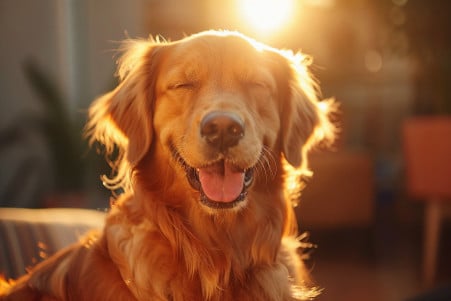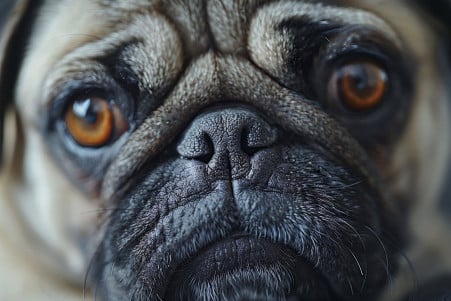Why Are My Dog's Eyes Dilated? The Meaning Behind Pupil Size
21 March 2024 • Updated 21 March 2024

If you've ever looked into your dog's eyes and thought that their pupils seemed to be taking up more space than usual, you might have wondered what's going on. When a dog's pupils dilate or get larger, it's often a sign of arousal. This can be arousal in response to something positive, like a high-value treat, toy, or person, or arousal in response to something negative, like a stressful situation. While dilation is a sign of arousal, it doesn't necessarily mean that a dog is stressed or threatened.
In this article, we'll take a look at the research in veterinary medicine and animal behavioral science to explore the many things that can cause a dog's pupils to dilate. These things range from survival instincts that dogs inherited from their wolf ancestors, to the way that different lighting conditions affect their eyes, to the way that their brain chemistry and emotional states can impact the size of their pupils.
By learning about this phenomenon, you can gain a better understanding of what your dog is feeling when their pupils dilate, whether they're feeling aroused, interested, or even a little stressed. Let's take a closer look at what your dog's dilated eyes are really trying to tell you.
Why are my dog's eyes dilated?
Survival Instincts and Evolutionary History
Dogs' dilated pupils can be linked to their wolf ancestors and their survival instincts. Pupil dilation was an evolutionary adaptation that helped wolves and other animals see better in low-light conditions when hunting and detecting prey or predators, according to Dogster. Although the environment of domestic dogs is very different and their needs have changed, this instinctual reaction has been retained. For example, you may see your dog's pupils dilate when they spot a squirrel or other small animal, which harkens back to their predatory instincts.
As VCA Animal Hospitals notes, the pupil changes size to control the amount of light that enters the eye. This allowed wolves and their descendants to see better in low-light conditions when hunting. Knowing this evolutionary history can help dog owners understand behaviors like pupil dilation when their dog is excited or focused. While this isn't a matter of life or death for dogs, this evolutionary holdover gives us a window into what our pets are experiencing. With their vision momentarily improved, that squirrel is in trouble!
How Lighting Affects Pupil Size
The pupil is the hole in the center of the eye that lets light in. Vetster notes that a dog's pupils will dilate, or get larger, in low-light conditions to let more light in and help the retina see better. This dilation is an automatic response and is part of the autonomic nervous system.
Dog owners will likely see their dog's pupils dilate when they come in from the sun or when it gets dark outside. According to PetHelpful, this is a completely normal physiological response and nothing to worry about unless it happens in conjunction with other symptoms. The pupils are simply adjusting to let in the right amount of light, a reflex that helps dogs see better in the dark.
Emotions and Pupil Dilation
A dog's emotional state can also lead to pupil dilation, even in bright light. PawSafe explains, that emotions like excitement, fear, or stress can lead to the release of hormones and neurotransmitters that can impact the size of a dog's pupils. This means that pet parents may see their dog's pupils dilate in situations that elicit strong emotional responses, like when they see their pet parent or when they're playing.
That said, Dogster points out that dilated pupils alone don't necessarily mean a dog is experiencing a negative emotion like fear or anxiety, but instead indicate a heightened physiological response. To understand a dog's emotional state, it's important to look at other body language signals and the situation as a whole. For instance, a dog with dilated pupils may be excited and interested in their surroundings rather than fearful or anxious.
Recognizing the relationship between a dog's emotions and pupil dilation can help pet parents better understand what their dog is going through. By paying attention to these subtle physical changes in conjunction with other signs of a dog's emotional state, pet parents can learn more about how their furry friend feels and react accordingly.
Medical Conditions and Pupil Dilation
While pupil dilation is often a normal response, it can also be a symptom of certain medical conditions in dogs. According to Vetster, conditions like glaucoma, head trauma, brain tumors, and exposure to toxins or medications can cause abnormal pupil dilation.
As WagWalking explains, persistent or unequal pupil dilation (anisocoria) may indicate an underlying issue that requires veterinary attention. Other symptoms that may accompany abnormal pupil dilation include eye redness, squinting, or lethargy. PetMD notes that the treatment approach depends on the underlying cause and can vary greatly, from no recommended treatment to surgery.
It's important for pet owners to closely monitor their dog's pupils and seek prompt veterinary care if any concerning changes are observed. Early detection and treatment of the underlying condition can help manage the issue and prevent further complications.
How to Monitor and Address Pupil Changes
To monitor your dog's pupils for any changes or issues, pet parents should make a point to check their dog's eyes regularly. Kingsdale Animal Hospital notes that keeping a log of pupil size and condition and noting any potential triggers or environmental factors can help you spot any worrisome trends. If you notice anisocoria or that your dog's pupils are staying dilated, make sure to get your dog to the vet as soon as possible.
When you take your dog to the vet, they will likely do a full physical and ocular exam, as WagWalking explains. They may also recommend other tests like blood tests, imaging, or pharmacological testing to determine the cause, as Vetster explains. The treatment and outlook will depend on the diagnosis, and some conditions may require ongoing care or surgery.
However, by monitoring your dog's pupils and making sure to take them to the vet if you notice anything unusual, you can help ensure that your dog stays as healthy as possible. Knowing what to look for and when to take your dog to the vet can help you make sure that your dog gets the care they need.
Conclusion: What Does It Mean When Your Dog's Pupils Are Dilated?
In conclusion, there are many reasons why a dog's pupils may dilate, from normal responses to light and emotional stimuli to potential signs of medical issues. Knowing the context and looking for other signs of a problem is important when interpreting this subtle change in a dog's eyes.
By paying attention to their dog's pupils in conjunction with other signs, pet parents can learn a lot about what their dog is feeling, from happy and curious to potentially uncomfortable or in pain.
In the end, understanding why a dog's pupils dilate can help strengthen the bond between people and their pets and ensure that dogs receive the care and attention they need.


